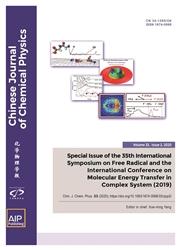Xe·N非共价相互作用的理论研究:XeO3和XeOF2的三杂交N
IF 1.2
4区 化学
Q4 PHYSICS, ATOMIC, MOLECULAR & CHEMICAL
引用次数: 5
摘要
通过DFT和MP2计算,研究了XeOF2和XeO3配合物与一系列不同的杂化n给体的相互作用。XeO3或XeOF2与典型含氮供体之间的气相键能在6.5 ~ 19.9 kcal/mol之间。含n杂化的相互作用顺序为sp3>sp2>sp,且XeO3高于XeOF2。对于sp2和sp3杂交的一些给体,空间位阻效应在相互作用中起次要作用,并有证据表明密度梯度图降低。主要的稳定部分是静电相互作用。在XeO3配合物中,极化的权重大于色散,而在XeOF2配合物中则相反。除Xe原子上的分子静电势最大值和N原子上的分子静电势最小值之和外,其他5个相互作用参数包括键临界点势能密度、平衡距离、基集叠加误差修正的相互作用能、局域分子轨道能量分解分析相互作用能、电子电荷密度。相互之间表现出很强的线性相关系数。本文章由计算机程序翻译,如有差异,请以英文原文为准。
Theoretical study on Xe⋯N non-covalent interactions: Three hybridization N with XeO3 and XeOF2
The interactions of complexes of XeOF2 and XeO3 with a series of different hybridization N-containing donors are studied by means of DFT and MP2 calculations. The aerogen bonding interaction energies range from 6.5 kcal/mol to 19.9 kcal/mol between XeO3 or XeOF2 and typical N-containing donors. The sequence of interaction for N-containing hybridization is sp3>sp2>sp, and XeO3 is higher than XeOF2. For some donors of sp2 and sp3 hybridization, the steric effect plays a minor role in the interaction with the evidence of reduced density gradient plots. The dominant stable part is the electrostatic interaction. In complex of XeO3, the weight of polarization is larger than dispersion, while the situation is opposite for XeOF2 complexes. Except for the sum of the maximum value of molecular electrostatic potential on Xe atom and minimum value of molecular electrostatic potential on N atom, the otherfive interaction parameters including the potential energy density at bond critical point, the equilibrium distances, interaction energies with the basis set superposition error correction, localized molecular orbital energy decomposition analysis interaction energies, and the electron charge density, show great linear correlation coefficients with each other.
求助全文
通过发布文献求助,成功后即可免费获取论文全文。
去求助
来源期刊

Chinese Journal of Chemical Physics
物理-物理:原子、分子和化学物理
CiteScore
1.90
自引率
10.00%
发文量
2763
审稿时长
3 months
期刊介绍:
Chinese Journal of Chemical Physics (CJCP) aims to bridge atomic and molecular level research in broad scope for disciplines in chemistry, physics, material science and life sciences, including the following:
Theoretical Methods, Algorithms, Statistical and Quantum Chemistry
Gas Phase Dynamics and Structure: Spectroscopy, Molecular Interactions, Scattering, Photochemistry
Condensed Phase Dynamics, Structure, and Thermodynamics: Spectroscopy, Reactions, and Relaxation Processes
Surfaces, Interfaces, Single Molecules, Materials and Nanosciences
Polymers, Biopolymers, and Complex Systems
Other related topics
 求助内容:
求助内容: 应助结果提醒方式:
应助结果提醒方式:


